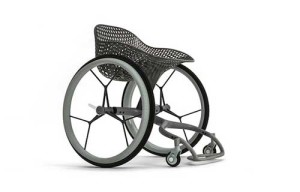Wheelchair is personalized to fit user’s body shape, weight and disability
In my conversations with design engineers working with medical device OEMs, a commonly voiced frustration is a lack of imagination. Medical devices look too much like medical devices.
“The last thing people with a disease state need to be reminded of is that they are sick,” Bryce Rutter, founder and CEO of Metaphase Design Group (St. Louis, MO), told me recently. In developing a medical product, design engineers “have to be thinking not just about usability and human factors but how we can ensure that the dignity of the user is not eroded day by day,” said Rutter. That’s what this stunningly designed wheelchair achieves. Developed by UK industrial designer Benjamin Hubert, founder of London-based design bureau Layer, in collaboration with 3D-printing pioneer Materialise (Leuven, Belgium), the GO prototype is described as the “first 3D-printed consumer wheelchair.” It will be launched during Clerkenwell Design Week, a showcase of UK and international design in central London that runs from May 24 to 26.
Since founding his design agency, Hubert has focused on “socially conscious quality-of-life enhancing design projects,” writes Slate in a recent article highlighting the GO wheelchair. LayerLab is the design bureau’s new research division, which was founded earlier this year to apply those principles. The wheelchair is the division’s inaugural project.
Hubert’s team of designers spent six months interviewing wheelchair users and medical professionals in an effort to remove the stigma associated with the device and restore a sense of dignity. They wanted to “create a more human-centered vehicle to improve the lives of everyday users,” writes Layer in a press release. A key design element is the personalized nature of the product, which is designed to fit the user’s body shape, weight and specific disability. 3D printing was integral to achieving this objective.
“We saw an opportunity to really progress the manual mobility category for users with disabilities, and to use 3D-printing technology to solve significant and meaningful problems,” said Hubert in a press release. It is the most appropriate and powerful technology available to capture each individual’s unique body shape to enhance the form and format of a very necessary product and provide exceptional performance, he added.
For instance, the user’s biometric information is used to design the seat, which is 3D-printed from a semi-transparent resin combined with thermoplastic polyurethane for elasticity, according to gizmag. The positioning of the seat is also based on body-mapping data to ensure an optimal center of gravity for the user. An accompanying GO app allows the user to specify wheelchair options, patterns and color schemes.
LayerLab says that it can produce and deliver the custom wheelchair in less than two weeks. No word yet, however, on how much it will cost.
Website: www.plasticstoday.com






